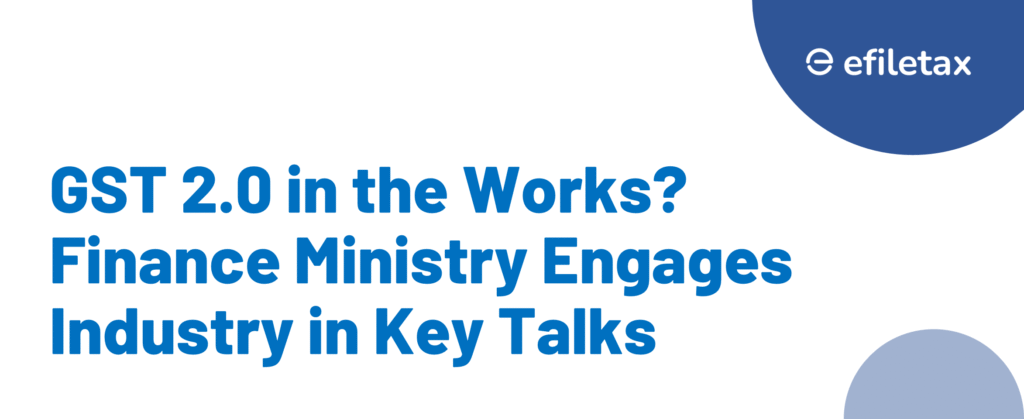
GST 2.0 Discussions Key Takeaways for Indian Taxpayers
The focus keyphrase “GST 2.0 discussions” is now trending among Indian tax professionals, as the Finance Ministry recently held consultations with industry leaders to discuss overhauls under the next phase of GST reform. While no draft bill has been released yet, signals from official channels suggest that major simplification, tech upgrades, and dispute resolution reforms are on the horizon.
Let’s decode what “GST 2.0” might mean for you.
What is GST 2.0?
GST 2.0 is not a new law — it’s a proposed revamp of the current GST system. The goal is to make it simpler, faster, and more transparent for taxpayers and administrators alike.
Key features being discussed:
- Automation-led compliance using AI and analytics
- Reduced tax slabs and rate rationalisation
- Input tax credit (ITC) streamlining to cut delays and fraud
- Unified return filing to replace multiple forms like GSTR-1, GSTR-3B
- Dispute redressal upgrades via the newly launched GSTAT (GST Appellate Tribunal)
Why Are GST 2.0 Discussions Happening Now?
- Revenue leakage: Fake ITC claims and mismatches are still common.
- Compliance burden: MSMEs find the return process complicated.
- Taxpayer feedback: Several industry groups flagged challenges with audits and notices.
- Digital India push: Government aims to create a seamless tax tech ecosystem by 2026.
What’s Likely to Change Under GST 2.0?
| Area | Current System | Proposed in GST 2.0 |
|---|---|---|
| Returns Filing | GSTR-1, GSTR-3B, GSTR-9, etc. | Unified Return (One form) |
| ITC Matching | Self-declared + auto-populated | Auto-validation using AI |
| Tax Slabs | 5%, 12%, 18%, 28% | 3–4 simplified slabs |
| Compliance Rating | Not yet implemented | Likely to launch soon |
| Small Business Support | Composition Scheme | Expanded threshold + relaxations |
Legal Angle: Official Signals from the Government
- CBIC Chairperson’s Speech (May 2025): Mentioned “major GST system simplification by FY 2026.”
- 45th GST Council Meeting: Recommended working groups for GST 2.0 structure.
- Budget 2025 Speech: FM indicated a phased rollout of a new compliance framework.
You can track such developments on the official GST portal: www.gst.gov.in
Expert Tip: Prepare Your Business Now
“Start cleaning your ITC reconciliation, vendor ledgers, and past notices. A tech-driven GST 2.0 system will likely flag legacy issues instantly.”
— Efiletax Advisory Team
How Should Indian Businesses Prepare?
✅ Review vendor compliance: Ensure all vendors file GSTR-1 timely
✅ Automate ITC matching: Tools like GSTR-2B vs 3B matching are essential
✅ Digital bookkeeping: Migrate to cloud-based accounting tools
✅ Train staff: Educate finance and audit teams on GST 2.0 expectations
✅ Track updates: Follow cbic.gov.in and Efiletax for reliable news
FAQs on GST 2.0 Discussions
Q1: Is GST 2.0 a new tax regime?
A: No. It is an upgrade of the existing system with better processes, not a replacement of GST law.
Q2: Will I need to change my return filing method?
A: Likely yes. A new consolidated return form is being discussed to replace current formats.
Q3: Are small taxpayers affected?
A: The new system may benefit small taxpayers through simplified rules and reduced slab rates.
Final Word
GST 2.0 discussions mark a serious push toward improving India’s tax infrastructure. As always, Efiletax will break down the reforms, explain legal updates, and guide you through the transition — one blog at a time.
✅ Ready to stay compliant? Start with Efiletax today.
Summary
The Finance Ministry has started GST 2.0 discussions to simplify returns, streamline ITC, and cut red tape. Expected reforms include unified returns, fewer slabs, and tech-driven compliance. Learn how businesses can prepare early for India’s next major tax system upgrade.